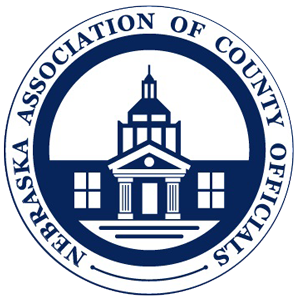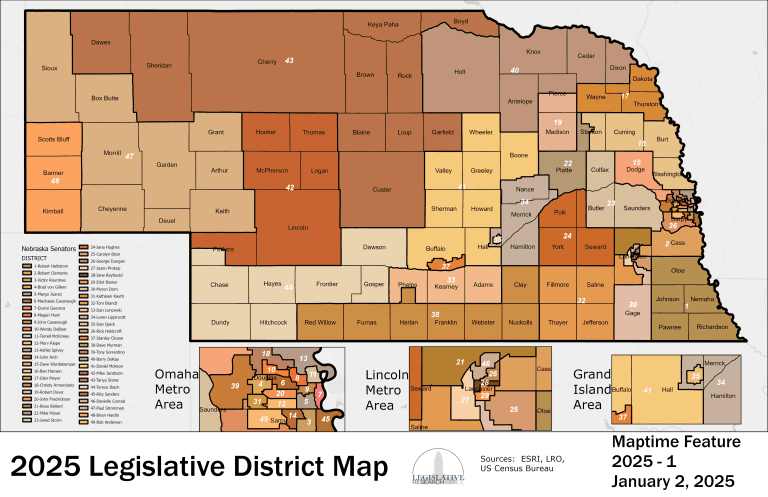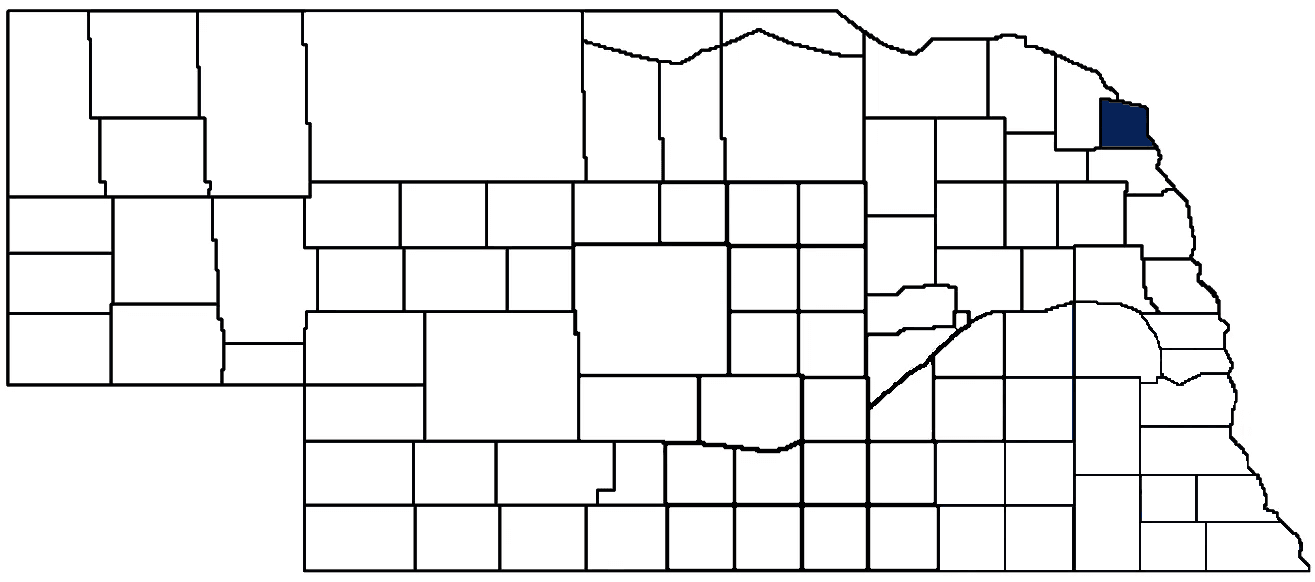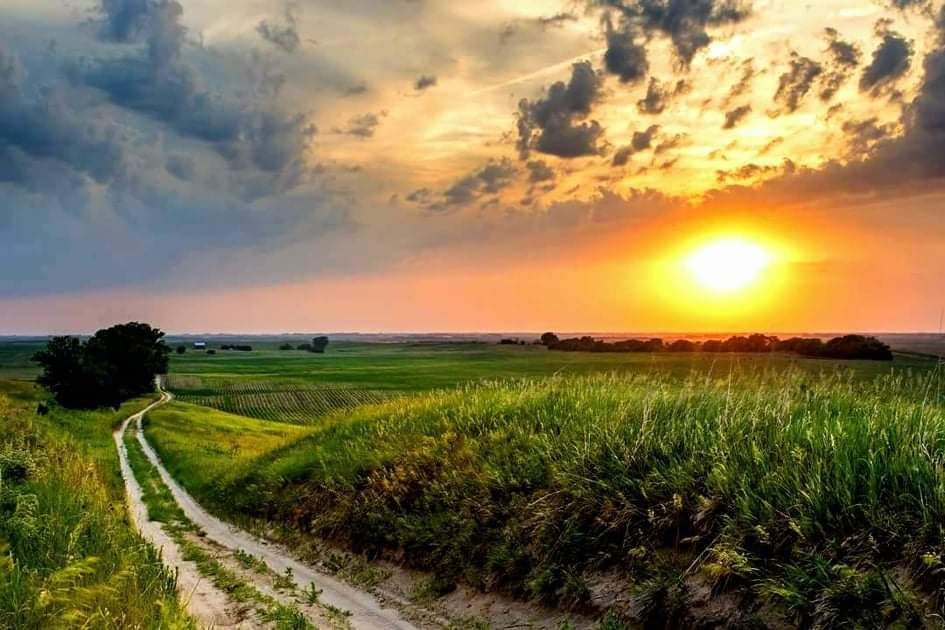- General Info
- Demographics
- Education and Employment
- Valuation and Taxes Levied
- State Senators
- History
- County Programs
- Other Information
Communities & Development
Dakota County Seat: Dakota City
Total County Population: 21,582
- Cities (pop. & class): Dakota City (2,081 • 2nd Class), South Sioux City (14,043 • 1st Class)
- Villages (pop.): Emerson (525), Homer (532), Hubbard (153), Jackson (207)
- Unincorporated Pop. (% of county pop.): 4,225 (19.59%) 2020
Land Development (% of total land in county):
- Agriculture: 78%
- By method: Dryland (row crop/grain/forage) (57%); Pasture (pure grassland) (11%); Irrigated (row crop/grain/forage) (10%) • Neb. Dept. of Rev. - total equals agriculture's %
- By commodity: Corn 38%, Soybeans 34%, Livestock (grassland) 8%, Alfalfa 2%, Other Hay 1% • USDA - equals agriculture's % plus some wetlands (2%) and minus public grassland/wetlands and reserve
- Residential, Commercial, Industrial, Conservation Reserve & Exempt (combined): 16%
- Timber: 6% 2022
County Offices
Courthouse Address and Hours:
1601 Broadway Street
Dakota City, Nebraska 68731
M-F 8:00 am - 4:30 pm
County Board Chairperson: Martin Hohenstein
Complete list of county board members
County Board Meetings: Every other Monday
View the County's Government Maps
NACO District: Northeast
General
Population: 21,582
Land area (sq. mi.): 264.28
Population per square mile: 81.7
Race & Age
Race 2020
White: 43.3%
African American: 7.4%
American Indian: 2.4%
Asian: 2.8%
Hispanic: 40.8%
Native Hawaiian and Pacific Islander: 0.7%
Native Hawaiian and Pacific Islander: 2.3%
Age 2020
0-17: 29.3%
18-64: 56.6%
65+: 14.1%
Households
Total households: 7,400 2020
With one child: 1,300 2022
With 2+ children: 1,760 2022
With seniors (65+): 1,420 2022
Socioeconomics
Median Household Income: $71,655 2023
% of Population in Poverty: 11.7% 2023
# of Housing Units: 7,765 2020
Owner-occupied rate: 64.5% 2020
Median home price: $175,260 Q4 2024
2024 building permits for detached single family homes: 37
2024 building permits for non-detached housing units: 0 (townhouse, duplex, or apt. unit)
Technology
Access to broadband (100 Mbps via fiber or cable modem): 90.4% 2021
Sources: National Association of Realtors, Nebraska Department of Revenue, Nebraska Legislature, Nebraska Library Commission, U.S. Bureau of Economic Analysis, U.S. Census Bureau (building permits), U.S. Census Bureau (demographics), U.S. Census Bureau (municipalities)
Employment, Schools, and Child Care
Unemployment rate: 3.8% March 2025
County Employment Website: https://dakotacountyne.org/webpages/links/public_notices.html
High school graduate or higher: 77.2% 2020
School Districts: Allen Consolidated Schools, Homer Community Schools, Ponca Public Schools, South Sioux City Community Schools
Bachelor's degree or higher: 14.7% 2020
Community College Service Area: Northeast Community College
Countywide child care capacity: 24 providers; 618 children 2024
Find child care: For a list of child care providers in your zip code, visit Nebraska DHHS or the Nebraska Resource and Referral System.
Dakota County Economy
Annual Gross Domestic Product (GDP): $2,280,332,000 2023
Nonfarm Small Business Receipts: $447,310,768 2022
Nonfarm Wage Income: $482,735,000 2022
Farm and Ranch Commodity Sales Receipts: $134,568,000 2022
Farm and Ranch Operations (Non-Sales) Receipts: $10,225,000 2022
- For components of nonfarm small business receipts, nonfarm wage income, and farm & ranch commodity sales and operations receipts, see "Notes" below.
Ethanol Plants (annual production capacity): Siouxland Ethanol (90 million gallons)
Grain Elevators by Location (bushels capacity):
- Dakota City: J. E. Mueret (1,498,143)
- South Sioux City: Richardson Milling (3,174,867)
- (1 bushel = 56 lbs. corn/sorghum, 60 lbs. soybeans/wheat; % max. moisture = 18% beans, 15.5% corn, 14% sorghum/soybeans, 13.5% wheat)
Railroad Miles: 35.34 main, 8.06 side
- Places with Railroad Service: Dakota City, Homer, Jackson
Farmers Market: Market on the Square (BrokenkBow) ( May 19 - September 8, Thursdays 10 a.m. - 3 p.m.)
Local Grain Market: Click for today's grain prices in Dakota County
Cattle Producers: 71
Crop Producers: 34
- Dryland Cash Rent (avg.): $280/acre 2024
Electricity Providers: City of Emerson, City of South Sioux City, Nebraska PPD, Northeast Nebraska PPD, Northeast Power
Wind Turbines Operating (MW): 2 turbines (MW unknown)
Notes
- Nonfarm small business receipts are reported by partnerships and sole proprietorships. They do not include receipts reported by cooperative associations.
- Nonfarm wage income is reported based upon the wage earner's residential address; therefore, it also includes wages earned by Dakota County residents in other counties or states, but it excludes wages earned in Dakota County by residents of other counties or states.
- Nonfarm wage income excludes wages earned by anyone claimed as a dependent.
- Farm and ranch commodity sales receipts and operations receipts are reported based upon the farm or ranch owner's principal county of operations; therefore, those figures also include receipts reported by producers operating principally in Dakota County for their production in other counties or states, but the figures exclude receipts reported for production in Dakota County by producers operating principally in other counties or states.
Irrigation, Drinking Water, and Soils
Rural Irrigation/Livestock Wells: 178 2024
Rural Commercial/Industrial Wells: 18 2024
Rural Drinking Water Wells: 132 2024
Drinking Water Utility Connections: 5,978 Residential; 366 Commercial; 15 Industrial 2024
Irrigation/Livestock Wells per Square Mile: 0.67 2024
Surface Water Diversions (Irrigation): 11 2024
Click for real time:
Streamflow data on the Missouri River at Siouxland Veterans Mem. Bridge (US Hwy 77)
Streamflow data on Omaha Creek at Homer
Sources: National Agricultural Statistics Service (USDA), Nebraska Cooperative Council, Nebraska Coordinating Commission for Postsecondary Education, Nebraska Department of Transportation, Nebraska Office of the CIO, Nebraska Power Review Board, U.S. Bureau of Economic Analysis, U.S. Bureau of Labor Statistics, U.S. Census Bureau
2024 Levies and Valuation
County levy rate: $0.3039 per $100 of taxable valuation
County property taxes levied: $8,243,415
Total local government property taxes levied: $38,573,505
Total countywide taxable valuation: $2,712,636,709
Federal PILT payment to Dakota County (FY2022): $2,691 regarding 804 federally-owned acres
Click here for all levy rates in Dakota County
County Levy and Taxation Laws
Levy limits
Since 1996, counties and other political subdivisions have been subject to the levy limits listed in Neb. Rev. Stat. § 77-3442 and Neb. Rev. Stat. § 77-3443.
Statutes and regulations:
Nebraska Revised Statutes (Chapter 77)
Nebraska Administrative Code (Title 350)
Local tax reductions, exemptions, and credits:
Neb. Rev. Stat. § 76-902(5)(a) (Deed "stamp tax" exemption): "The [stamp tax] shall not apply to: ... (5)(a) Deeds between spouses, between ex-spouses for the purpose of conveying any rights to property acquired or held during the marriage, or between parent and child, without actual consideration therefor."
Neb. Rev. Stat. § 77-201(2) (Valuation of agricultural land and horticultural land): "Agricultural land and horticultural land as defined in section 77-1359 shall constitute a separate and distinct class of property for purposes of property taxation, shall be subject to taxation, unless expressly exempt from taxation, and shall be valued at seventy-five percent of its actual value, except that for school district taxes levied to pay the principal and interest on bonds that are approved by a vote of the people on or after January 1, 2022, such land shall be valued at fifty percent of its actual value."
Neb. Rev. Stat. § 77-6703(1) (Tax credit for school district taxes paid): "(1) For taxable years beginning or deemed to begin on or after January 1, 2020, under the Internal Revenue Code of 1986, as amended, there shall be allowed to each eligible taxpayer a refundable credit against the income tax imposed by the Nebraska Revenue Act of 1967 or against the franchise tax imposed by sections 77-3801 to 77-3807. The credit shall be equal to the credit percentage for the taxable year, as set by the department under subsection (2) of this section, multiplied by the amount of school district taxes paid by the eligible taxpayer during such taxable year."
Sources: Nebraska Department of Revenue
State Senator: Glen Meyer (District 17)
Committees
- Education
- Health and Human Services
- State-Tribal Relations
Map and statistics for Legislative District 17
Map of all districts in the Nebraska Unicameral Legislature
Dakota County History
Number of Registered Historic Places: 5
Year Authorized: 1855
Year Organized: 1855
Etymology: Dakota Sioux Native American tribe
Fort Charles, a fur trading posted located along the Missouri River, stakes its claim as one of the oldest businesses in Nebraska. Remarkably, records indicate that Fort Charles was conducting business for the earliest settlers more than 70 years before Nebraska became a state. In fact, historians believe that Lewis and Clark passed through the post in 1804 (referred to as Mackay’s Trading House in Clark’s journal).
Dakota County takes its name from the Dakota Sioux tribe, who inhabited the territory for hundreds of years prior to the arrival of European settlers. The precise meaning of the word Dakota is unknown; although some researchers have roughly translated the word to “friend,” “allies,” or “brothers,” Dakota remains an ancient word whose precise meaning has been lost through the ages. Some anthropological research has traced its origin back to the word “endakutha,” featured in a song sung by members of an ancient Omaha tribal society. The true origin of the word Dakota, taken in context with the verse, can be approximately translated as, “The Divine Power is a shield to the chosen people.”
In 1855, Dakota County witnessed the drawing of its first county boundaries and saw Dakota City emerge as the first county seat. However, a few years later, a rival town named St. John’s attempted to wrest the honor from Dakota City, claiming its more central location merited the county seat. An election was held, and Dakota City retained the county seat by a mere three votes.
Several early settlers in Dakota County would later win state and national positions of public service, including Williams James, who served as Nebraska’s Secretary of State, and John Taff, who served three terms in the U.S. Congress following his service to the Nebraska Volunteer Cavalry in the Civil War.
Highlight an important program in your county in this space! Send an email to:
Local Highlights
License Plate Number: 70
Time Zone: Central
Number of Veterans: 856 2023
Zoned County: Yes
Number of County-Owned Bridges: 46
Number of County-Owned Dams: 1
Election Data
General Election Turnout: 60% 2024
Total Registered Voters: 10,550 2024
Number of Precincts: 12 2022
Number of Election Day Polling Places: 12 2022
Land Area per Polling Place (avg.): 22.29 sq. miles
Intergovernmental Data
Emergency Mgt. Planning, Exercise and Training (PET) Region: Northeast
Natural Resource District: Lower Elkhorn NRD, Papio-Missouri River NRD
State Lands (acres): Basswood Ridge WMA (360), Danish Alps SRA (746), Omadi Bend WMA (32.79)
Federal Lands (acres): Snyder Bend (875.12)
Sources: Nebraska Department of Transportation, Nebraska Emergency Management Agency, Nebraska Game & Parks Commission, Nebraska Legislature, Nebraska Office of the CIO, Nebraska Secretary of State, U.S. Department of Veterans Affairs, U.S. Election Assistance Commission, U.S. National Archives and Records Administration (eCFR)



